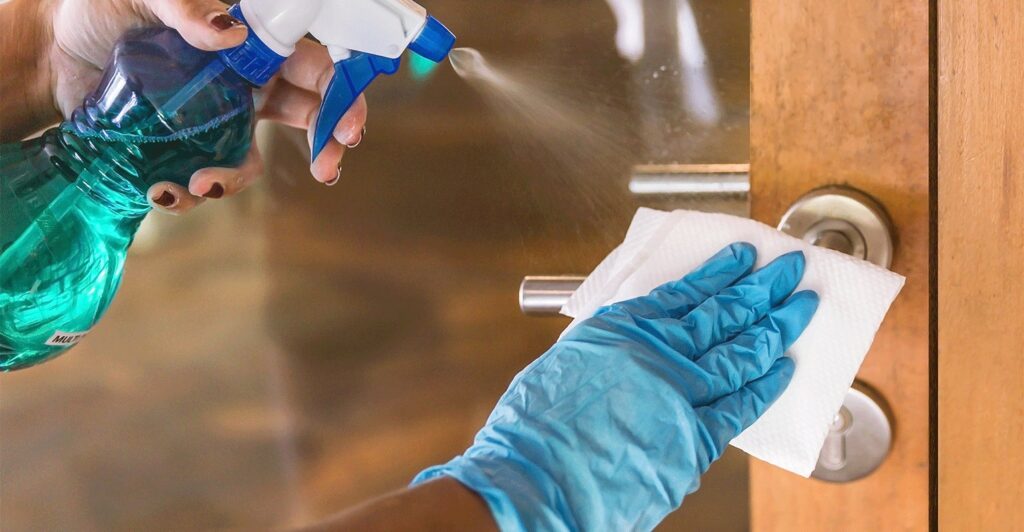03 Jul, 2020
Restaurant Cleaning Guide During COVID19 Pandemic
It’s probably a love of food that got you into the restaurant business, so it’s understandable if you don’t also have an abiding love for the mundane tasks involved in running a restaurant, like cleaning it. But now more than ever, with the spread of the flu and COVID-19, your restaurant needs to be the most sanitary it’s ever been to protect your guests and your staff from getting sick.
When it comes down to it, restaurants are already some of the most regularly cleaned public spaces around. You’re probably already doing a lot of what needs to be done to prevent the spread of germs in your restaurant — all you’ve gotta do now is ramp up your sanitizing, increase your hand-washing protocol, and make sure your staff aren’t coming to work sick. Make sure your staff know that nothing matters more than their health and the health of your customers.
Use routine cleaning procedures
Early evidence suggests that the COVID-19 virus can survive for several days at room temperature. However, special processes beyond routine cleaning and sanitizing are not recommended at this time. Regular household cleaners as well as a simple bleach solution (½ cup bleach to 1 gallon of water) have been shown to be effective in preventing the spread of COVID-19 and other viruses.
Cleaning and sanitizing

- Remember, cleaning and sanitizing are not the same. Clean with soap and water to remove dirt and food from surfaces. Sanitize with chemicals or heat to reduce germs. Surfaces that look cleanmay still have germs on them that you can’t see. Sanitizing reduces these germs to safer levels.
- Clean and sanitize surfaces that are frequently touched. Surfaces such as remote controls, kitchen counters, door knobs, bathroom surfaces, keyboards, tables and chairs, and phones and tablets should be cleaned often.
- Follow the instructions on your cleaner for how long the surface needs to remain wet for it to be effective.
- Food-contact surfaces should be washed, rinsed, and sanitized after each use.
Promote proper handwashing
- Make sure handwashing signs are put where employees can see them.
- Wash hands thoroughly with soap and warm water for at least 20 seconds.
- Dry hands with paper towels and throw the paper towels in the trash.
Remember to wash hands:
- After coughing, sneezing, and wiping your nose.
- After using the bathroom.
- When preparing foods.
- When switching from preparing uncooked foods to working with ready to eat foods.
- After touching your face or hair.
- After touching animals.
- After eating and using tobacco/nicotine.
- After handling money or other forms of payment.
- After handling dirty equipment or utensils.
- Before putting on disposable gloves.
- Whenever hands become dirty.
Cleaning and sanitation program in food premises
In Canada, a cleaning and sanitation program in food premises includes identifying areas, equipment, utensils, and surfaces that require cleaning and sanitizing/disinfecting, the frequency and procedures of cleaning and sanitizing/disinfecting, and the types of products used for cleaning and sanitizing/disinfecting. Food premise operators should review their existing cleaning and sanitation programs to identify areas where increased frequency of sanitizing and disinfection is warranted, and whether the disinfectants used have been approved for use against SARS-CoV-2. The BC Centre for Disease Control recommends regularly cleaning and sanitizing all food contact surfaces such as food prep tables, kitchens, and packaging areas. Customer service areas exposed to the public should also be cleaned and disinfected, and non-food contact high-touch surfaces such as hand-held POS devices, menus, chairs, bathrooms, and door knobs should be disinfected with an approved disinfectant product.
Household bleach is considered a disinfectant if used at 1000 to 5000 ppm solution with 10 minute contact time. As SARS-CoV-2 is an enveloped virus, it can be inactivated with a 500-1000 ppm bleach solution, while pathogens such as norovirus may require 5000 ppm bleach solution to be inactivated. This online chlorine calculator is useful to calculate the appropriate amount of bleach to add to a certain amount of water to achieve desired concentration solution. Never mix disinfectant products as this may result in toxic by-products that may be dangerous to the user. When bleach is mixed with ammonia (found in some glass and window cleaners, interior and exterior paints, and urine), chloramine gases are produced. Symptoms of chloramine gas exposure include coughing, shortness of breath, chest pain, and nausea. Mixing bleach with acids (found in vinegar, some toilet bowl cleaners, drain cleaners, and dishwasher detergents) produces chlorine gas. Chlorine gas is an irritant even at low levels and causes coughing, breathing problems, burning and watery eyes, and a runny nose. When chlorine gas is combined with water, hydrochloric acid is produced, which causes burns to the skin, eyes, nose, throat, mouth, and lungs.
Approved sanitizers and disinfectants used against SARS-CoV-2

Health Canada uses stringent safety, efficacy, quality, and labelling regulations and standards to approve disinfectant products for sale in Canada. Sanitizers without disinfectant claims are not regulated through the same channels. Approved disinfectant products must have a Drug Identification Number (DIN). In response to COVID-19, Health Canada is implementing interim measures to address potential disinfectant product shortages and to ensure Canadians can access disinfectant products that can be used against SARS-CoV-2:
- Facilitate expedited access to disinfectants through special approval for sale of products that may not be fully compliant with labelling requirements, or that are not authorized for sale in Canada but are authorized or registered in other jurisdictions with similar regulatory frameworks and quality assurances as Canada. The list of disinfectant products approved under the interim measures can be found on the Health Canada website.
- Provide a regularly-updated list of hand sanitizer and disinfectant products approved against SARS-CoV-2. Practitioners and consumers are advised to check products using this list to ensure that they are approved for use against this emerging pathogen.
